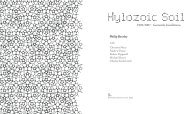The Inner Studio - Riverside Architectural Press
The Inner Studio - Riverside Architectural Press
The Inner Studio - Riverside Architectural Press
Create successful ePaper yourself
Turn your PDF publications into a flip-book with our unique Google optimized e-Paper software.
THE INNER STUDIO<br />
come to symbolize the standoff between superpowers. As with<br />
many walls, we may never know who designed it–it was not a work<br />
of beauty but a line of war, violence, danger, and irreconcilable<br />
hatred between enemies. It was a place that separated right from<br />
wrong. <strong>The</strong> Berlin Wall showed the world where superpowers meet<br />
and how they meet. It was an ugly standoff; a world-sized symbol<br />
of harm and separation that proved no compromise was possible.<br />
It also happened to be an enormous concrete and steel wall with<br />
armed guards that divided a city. And instead of seeing the oftthreatened<br />
war of mutual destruction, we saw the wall come<br />
tumbling down in a youthful burst of liberating energy. <strong>The</strong><br />
divided city of Berlin was made whole in an intoxicating celebration<br />
that was like some kind of ritual. I felt the almost archetypal<br />
power of a wall as symbol activated and I wondered what these<br />
images would mean for all of us who had lived with walls and separation<br />
not of our choosing.<br />
A wall is an ordinary thing. Without walls we would not be able<br />
to make rooms. We would not be able to divide space or separate<br />
activities or have privacy. We would have no place to put our<br />
windows and doors. At one time walls were not easily built or<br />
removed; many towns and countries owed their safe existence to a<br />
strong stone wall. Successive walls measure some cities as generations<br />
of inhabitants renewed their safety by rebuilding each wall<br />
ever further from the core of the town. Today a wall is not a realistic<br />
way of defending ourselves from military attack. But we remain<br />
dependent on walls for psychological protection and emotional<br />
safety. With psychological walls come the idea of boundaries, divisions,<br />
and separation as well as the possibility of breakthroughs<br />
and openings.<br />
As I watched the destruction of the Berlin Wall in 1989, I<br />
wondered if something inside us might also be changing, that an<br />
internal shift was now possible. Perhaps all of us who saw the<br />
images of the Berlin Wall collapsing understood that no matter what<br />
beliefs we had built, no matter how deeply held a particular attitude,<br />
or how much public effort we had made to convince ourselves<br />
and our enemies of our righteousness, our position was not permanent<br />
and could never be secure. <strong>The</strong> Berlin Wall was the greatest<br />
166





